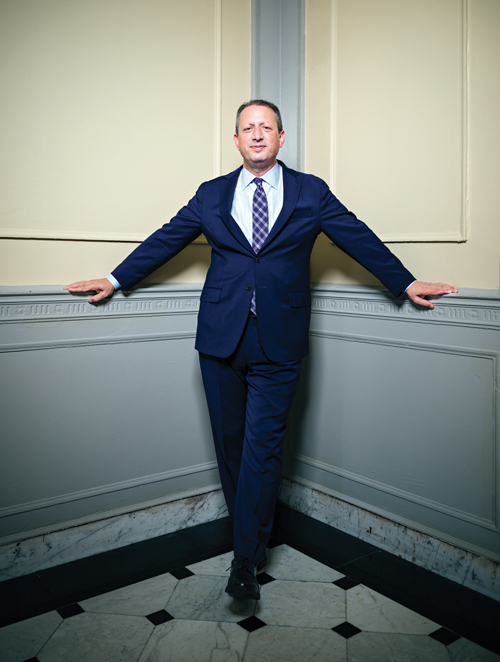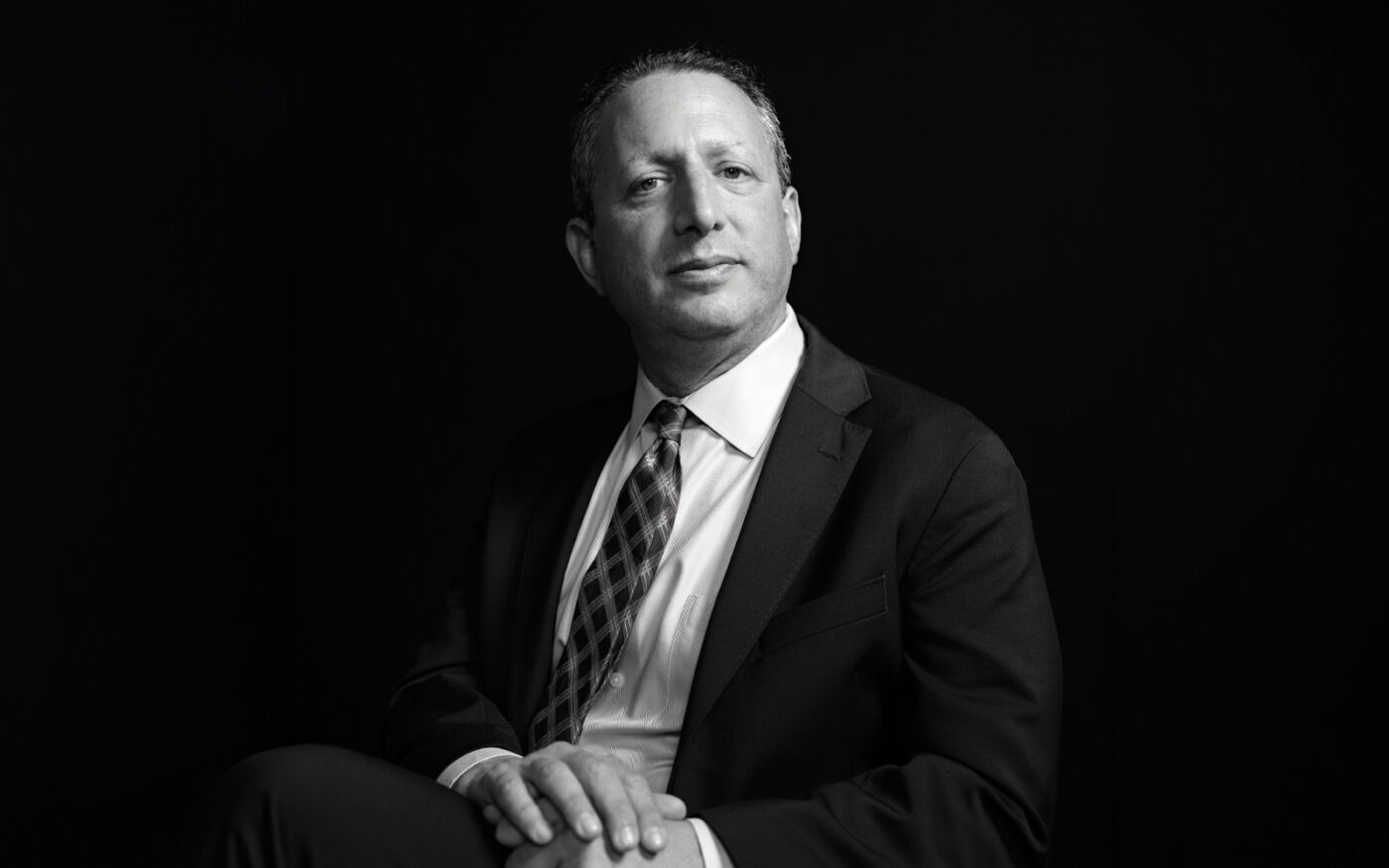City Comptroller Brad Lander bought a two-bedroom co-op in Park Slope Brooklyn in the 1990s for $125,000, the kind of home ownership opportunity that has disappeared from the city, especially the tree-lined streets of brownstone Brooklyn.
Home ownership is a key part of Lander’s housing platform as he vies to unseat Mayor Eric Adams in 2025. He’s also putting forth social housing models, including limited equity cooperatives, and he has a strategy he thinks will help the city build more housing — helping New Yorkers “see themselves” in growth.
Still, some in the real estate industry are not fans, though their opinion of Lander may matter less for his prospects than the legal scandal engulfing the city.
Hours after news broke on Sept. 25 that Adams had been indicted on five federal corruption charges, Lander called for the mayor to step down and offered his help to the public.
“At this urgent moment, the city’s leaders must focus on how we can best enable steady governance so that New York City can move forward and thrive,” he wrote on X. “As the comptroller of the city, I will do everything I can to help ensure this happens.”
Lander became comptroller in 2021 after 12 years in the City Council. Some past positions are what put him at odds with the real estate industry. In the Council, he proposed legislation that would have barred for-profit companies from acquiring city-owned land intended for affordable housing. As comptroller, he urged lawmakers to reform the state’s property tax system rather than revive the property tax break 421a. When he was running for comptroller, he vowed to reject donations from the industry.
Though he has pushed legislation that promotes nonprofit housing development, Lander says the housing shortage should also be addressed through private development and more social housing options.
This conversation has been condensed and edited for clarity.
Born: July 8, 1969
Hometown: University City, Missouri
Lives: Park Slope, Brooklyn
Family: Married, two children
What was your experience growing up outside St. Louis?
It made me want to live in a big city. I love going back to visit, and I love the St. Louis Cardinals, but I was definitely hungry for a place with more vitality, energy and diversity.
What were you like as a kid?
Nerdy. I don’t think that’ll shock anyone.
Your father was a bankruptcy attorney and your mom was an elementary school counselor. Would you say that your parents helped shape your interests?
For sure. My dad was a [nonprofit] lawyer before he was a private-sector bankruptcy attorney. I was 4 or something, doing these drawings of the buildings downtown, writing “no more poor,” although I misspelled “more.” It was definitely kind of a Midwestern liberal Jewish family with, like, “Work hard and find ways to contribute.”
“[My upbringing] was definitely kind of a Midwestern liberal Jewish family with, like, ‘Work hard and find ways to contribute.’”
What was your first job?
A referee in little league sports. I had played soccer, baseball and basketball in the Olivette Athletic Association, the next town over. A great job when you were a teenager was you could be the referee or then the umpire for the games, and then I was the head referee. That was a lot of fun.
You have a master’s degree in anthropology. Why did you choose that subject, and does it inform your work?
I have two master’s, one in anthropology and one in city planning, and I really think they go well together. What city planning teaches is to take that bird’s-eye view: How can we build a city and the infrastructure that works at a system level for this place? Anthropology is the street-level view: What are people thinking about their neighborhoods and the patterns of their daily lives? I got the anthropology degree in London, studying gentrification in London Docklands, this community that had been the old docks, kind of working-class community that then had all these South Asians, Bangladeshis and Pakistanis come. And then was being gentrified in the first wave of finance gentrification.
I did field work talking to people in this little neighborhood called Wapping, right next to Canary Wharf, the first office-led redevelopment that was taking place in East London. Talking to people about what that transformation and growth meant to them: What did they feel excited about? What did they feel displaced by? In some ways, that combination of what policies or systemic investments are needed and on the other hand, how do the people feel about it? What does it mean? What transformations are taking place, and what kind of policies could make people feel invested?
Did that experience of going out and talking to people influence your decision to take on more public-facing roles?
I mean, I like the spreadsheets and the numbers and the deal work, too. I didn’t want to get stuck doing just one or the other. There’s something fun about the experience of trying to make a deal pencil out, or being in the weeds on the Gowanus rezoning and figuring out what could actually get it done. On the flip side, there’s something fun about talking to people and trying to figure out what they want.
You’ve pointed to the Gowanus rezoning as a key success of your time as a Council member. How can you replicate that success through other rezonings?
I want to do for New York City what I did for Gowanus: set the table for genuinely inclusive growth in a way that can generate a more thriving and affordable future.
But there was some opposition.
There definitely was. But because we had this civic infrastructure for a conversation, people stuck with it. The public housing residents knew they weren’t gonna get everything they wanted, but they had to get enough to feel like it was real. From the beginning, [we] said we’re going to need a long-term oversight task force. There’ll be a rezoning that lets developers do a lot more development as-of-right, and then there’ll be all these promises of city investments and programs, but those won’t take care of themselves. So we stood up the Gowanus oversight task force that is really a model for making sure that if you get that kind of good deal in place, it’ll actually be implemented.
The Gowanus rezoning took eight years to complete, so replicating the timeline is not ideal. How do you speed up the process?
I still want to charge three of those years to the de Blasio administration, because we did our community planning work literally in the first week of the new administration. In 2014, I was in City Hall pitching Deputy Mayor [Alicia] Glen. I’m like, “Let’s do Gowanus first.” They were like, “Gowanus is complicated. We’re gonna do some other neighborhoods first.” They didn’t pick it back up until 2016.
We need a range of strategies. I broadly support City of Yes. That’s one good strategy, but it’s only going to get us, I think, a fifth of the moonshot goal [of 500,000 new homes]. You also are going to need these place-based or neighborhood rezonings. Can it go faster? Absolutely could go faster. The question is, what will help [people] feel enthusiastic about [it]? It’s not going to work to do it with a kind of take-your-medicine approach. It is true that an economic analysis of supply and demand chart says we need more housing for long-term affordability. Very few New Yorkers are going to find that a compelling argument. You’ve got to be able to say to people, “This thing is going to make your community, your lives, your kids’ lives, better.” There are tools like that.

Such as?
Affordable home ownership opportunities for working middle-class families. [If they can say,] “That’s where my kid is going to be able to buy a unit in our neighborhood,” there’ll be a lot more enthusiasm.
Do you think that real estate as an industry is still viewed as toxic in political circles?
I think some of that has shifted again. Barack Obama and Kamala Harris — they didn’t say “yay developers” in their [Democratic National Convention] speeches, but they did speak about the need to build more housing. I think you see that in the city as well, including from many progressive elected officials. The goal is a more affordable, more livable, thriving city. The goal can’t be the profit margin of real estate developers, but there is a recognition that those things are going to have to go together. We need a lot more housing built, and developers build housing, so it’s important to have them as one stakeholder, one partner, in the process. The polarized version, where YIMBYs are on one side and NIMBYs on the other, is not nearly as helpful.
How would you describe your relationship with the industry?
I [have my own] North Star, but I’m thoughtful and eager to find good partnerships. We’ve had really good relationships. We’re working with Related on the Signature Bank transaction. That’s profit, nonprofit and government in partnership, in a way that generates good returns. You’ll find people that say [about me], “We don’t always agree, but this is somebody who approaches things with a goal of getting to a good partnership.”
Many mayors, including Adams, have vowed to tackle the property tax system. As mayor, would you actually do that?
I will propose a comprehensive property tax reform in my first year, but we do need Albany. The mayor needs to lead to make this happen, but it’s going to have to include the legislature and the governor to get fair, effective, comprehensive property tax reform. The mayor, 18 months ago, told [Council members] Joe Borelli and Kevin Riley and me he would do it that spring, and has failed. Bill de Blasio waited until the third-to-last day of the administration to put his plan out.
You are a Cardinals fan. What are your other unpopular opinions?
I guess comprehensive planning is unpopular in the real estate community, but I still believe it’s a good idea.
What’s your greatest vice?
Sugar, I guess. I eat too much Ben & Jerry’s. I drink too much Coca-Cola.
What’s one lesson you hope your children learn from you?
Look out for each other. I love that line at the end of “Freakonomics”: “Take care of yourself, and if you can, somebody else too.”
What do you consider your greatest success?
The Gowanus rezoning and the District 15 middle school integration plan, both of which are achieving their goals and took at least a little bit of courage. On both, political advisers said, “Why would you do that? People are not going to be happy with it.”
What’s your biggest regret?
I have things I know I got wrong. I was wrong in opposing the way the 7 [train] extension was done and Hudson Yards took place. Probably my biggest regrets are those speeding tickets, and not just because I sped but because I had built a relationship with this community of advocates who had lost family members. [Lander has amassed more than 100 traffic violations, including several speeding tickets in school zones.] I legislated and fought for new rules in a way that honored that partnership, and I didn’t act personally in a way that honored that partnership. That really stunk.
How important is it to you to admit when you’ve gotten something wrong?
Really important. We all come in with our priors, and sometimes we’re right and sometimes we’re wrong. Everybody operates with a set of values and a set of mental models, and being open to where those get it wrong, I think, is important in public policymaking, but it’s also just so important for us, if we’re going to have this diverse and different place, you just have to be open to the fact that your way is not always right.
